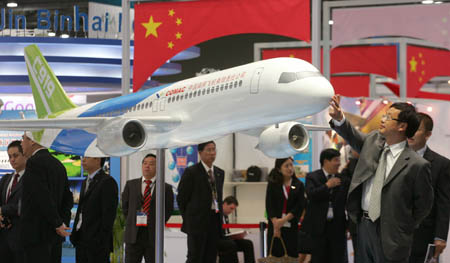Major Achievements in 2009
Production begins on China's jumbo jet
By Lillian Liu (China Daily/Agencies)
Updated: 2009-09-09 07:50
 |
Large Medium Small |
|
|
China's largest domestically-produced jumbo jet made its international debut at Asia's biggest air show in Hong Kong yesterday, in a demonstration of the country's ambition to be a global aviation giant.
The single-aisle C919 is a jetliner with up to 200 seats that could boost the country's fledgling aviation industry to compete with Western rivals like Boeing Co. and Airbus SAS. The C919 was designed by Commercial Aircraft Corporation of China (COMAC).
The plane is scheduled to take its maiden voyage in 2014 before being delivered to buyers in 2016, according to Wang Wenbin, an official of the COMAC.
Work on the prototype began last week, he said. A car-sized mock-up of the jet was on display yesterday at the Asian air show.
The project is a major first step by China toward the production of commercial planes, along with the research and technology capabilities for its fast-growing domestic market rather than relying on foreign companies. It would also pave the way for international expansion.
Because China's nascent commercial aerospace industry still lacks expertise, the C919 initially will be outfitted with engines and other parts from foreign companies.
|
||||
The C919 is designed for short- to medium-range hauls up to 5,555 km, and can seat as many as 200 depending on the configuration. According to state media, the first "9" in the jet's name was chosen because it suggests eternity in Chinese culture, with the "19" referring to the 190 seats the plane might accommodate. The "C" stands for COMAC.
Executives from global aviation suppliers are expected to make visits to China's main aircraft maker in the coming three months as the latter will select engine suppliers for the country's first-ever jumbo jet by the end of 2009.
COMAC is currently in talks with major engine suppliers, including General Electric, Rolls Royce and United Technologies Corp's Pratt & Whitney, a senior executive of the firm said at the Asian Aerospace International Expo and Congress in Hong Kong yesterday.
COMAC will select engine suppliers for the C919 project by the end of 2009, said Chen Jin, general manager of COMAC's sales and marketing department.
"We expect the C919 will have its test flight in 2014 and be delivered to customers in 2016," he added.
The profitable C919 project, believed to enable engine suppliers to pocket nearly $200 billion by 2050, has attracted proposals from global aviation suppliers.
Officials from General Electric, the US technology conglomerate, have made repeated visits to Shanghai-based COMAC over the last month and have said they are confident that the company will win contracts to supply engines for China's largest aircraft project.
The company's aircraft engines are the best and that makes the company very confident about being chosen as a supplier, Mark Norbom, GE's China president was quoted by Reuters as saying.
COMAC declined to comment on which company would be the potential winner but indicated foreign suppliers that design and manufacture products with Chinese companies would be preferred candidates.
Among the key selling points that would help China take on Boeing and Airbus are efficiency and costs, according to Chen Jin, COMAC's sales and marketing chief.
Compared to similar jets made by the two global aviation giants, the C919s will be cheaper for airlines to operate. They will also use between 12 and 15 percent less fuel, Chen said in an interview with The Associated Press.
But the day when China is poaching orders from Western companies in their own markets is still far off. Marketing of the C919 will be directed at the mainland at first, likely local carriers such as Air China and China Eastern, before going global.
"It depends on the market," Chen said. "The market is changing all the time."
Also in development by Shanghai-based COMAC is a 70 to 110-seat ARJ-21 passenger jet, designed for the local market.
Last year, General Electric Commercial Aviation Services signed a deal to order 25 of ARJ-21s. GE is supplying the engines for the project.












